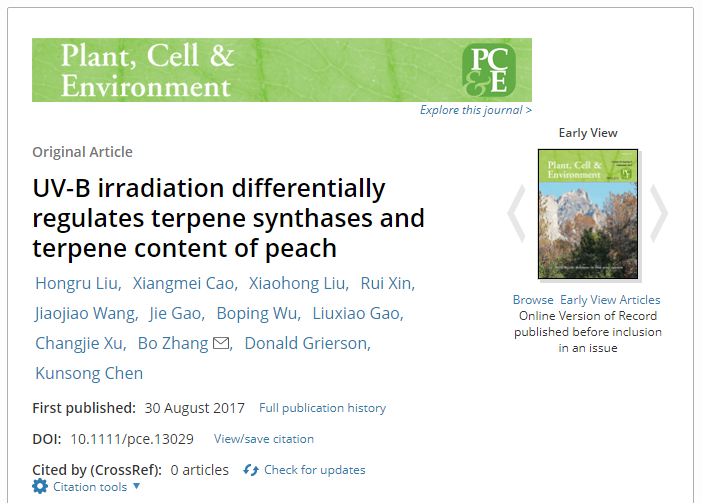Fruit quality biology research team revealed that peach fruit volatiles were regulated by UV-B irradiation. The results were published on line by Plant, Cell and Environment (5 year impact factor=6.555) entitled “UV-B irradiation differentially regulates terpene synthases and terpene content of peach” (DOI: 10.1111/pce.13029). Ph.D student Hongru Liu is the first author, Dr. Bo Zhang is the corresponding author.
Plants generate diverse adaptive responses to UV light, causing changes in morphological and biochemical changes. Although the effects of UV-B on the accumulation of some metabolites have been studied at the genetic level, the role of UV-B irradiation in influencing protectants and flavor-related volatiles, has not been elucidated. Over multiple seasons replicates on multiple cultivars of peach fruit, we observed that UV-B had greater effect on volatile production than UV-C, UV-A, UV-420 and visible light. Although induced emission of isoprene has been observed in some plants and shown to protect leaves against UV-B-induced rapid heating, no isoprene was detected in peach fruit after UV-B irradiation. In response to UV-B irradiation, peach fruit and leaves showed up to 3-fold accumulation of defense-related (E,E)-α-farnesene, but reduced the flavor-related linalool by up to 60%. RNA-sequencing together with molecular and biochemical assay tool-box, revealed that PpTPS1 was associated with production of linalool, while PpTPS2 was responsible for (E,E)-α-farnesene biosynthesis. Candidate transcription factors such as regulatory genes for these responses were identified such as WRKY and AP2/ERF.
Fruit bagging is widely applied in Asia to maintain marketable yield and quality. Based on discovery in the laboratory described as above, we compared effects of different bags on peach fruit flavor quality and volatile production. Consumer tests showed that peach fruit covered with white bags were rated lower for overall aroma and flavor preference, indicating that flavor components of peach fruit can be modulated by selecting an appropriate source of environmental screening material.
This research was supported by the National Key R & D Program of China (2016YFD0400101), the National Natural Science Foundation of China (31672100), and etc.
Article linkage: http://onlinelibrary.wiley.com/doi/10.1111/pce.13029/full
